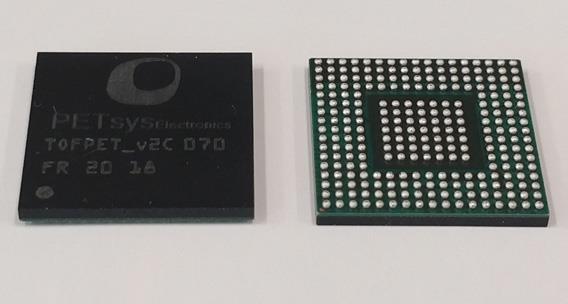PETsys TOF ASIC E. KIT
PETsys Time-of-Flight ASIC evaluation kit
|
|
|
|
|
Figure 2: PETsys TOFPET2 ASIC. The 64-channel PETsys TOFPET2 ASIC is available as a BGA package. |
|
|
|
|
Figure 1: TOF ASIC evaluation kit. The PETsys TOF ASIC evaluation kit consists of a FEB/D board (left) with Ethernet link to the computer, and a mechanical assembly (right) with two FEM128 font end modules, two KETEK SiPM pixels, two LYSO crystals and a holder for placing a 22Na source in between. |
| The evaluation kit comes with a FEB/D board with Ethernet link to the computer, and two FEM128 font end modules (Fig. 3). Each FEM128 has two ASICs reading 64 channels each. The FEM128 modules have connectors that directly accept the Hamamatsu S13361-3050Ax-08 8x8 MPPC array, or the KETEK PA3325-WB-0808 array. With a suitable adapter board, the FEM128 will equally well read analog SiPM arrays from other vendors. |
|
Figure 3: FEM128 module. The FEM128 module has two ASICs, and has connectors accepting a Hamamatsu S13361-3050Ax-08 MPPC 8x8 array, or a KETEK PA3325-WB-0808 array. With the e-kit we standard ship two FEM128. |
|
Flexible cables connect the FEM128 boards to the FEB/D board, providing great flexibility in the experiment setting. For an easy start we supply the evaluation kit with two KETEK SiPM pixels mounted on a board that plugs in the connector on the TOFPET2 ASIC test board, two LYSO crystals of 3x3x5 mm2, and a holder for placing a standard circular 22Na source in between. We also include a cooling box with two Peltier elements (Fig. 4). The box provides a stable temperature environment allowing reproducible measurements, and also protects the measurement setup from ambient light. The evaluation kit is provided with firmware and software. The data acquisition software runs under Linux and comes with an easy to use graphical user interface, see figure 5. The software is written in Python and C++, and is also provided as source code, allowing the advanced user to customise it.
|
 |
 |
|
Figure 4: Cooling box. A box with two Peltier cooling elements provides protection against ambient light and allows stable and reproducible temperature conditions. |
Figure 5: Graphical user interface. The data acquisition is controlled by an easy to use graphical user interface.
|
Included in the price of the evaluation kit there is a hands-on and individual training for one or two people. The training introduces the user to the use of the evaluation kit, the readout electronics and the software.
Main Features
- 1. Two FEM128 modules (Fig. 3), and two cables for connecting the modules to the FEB/D board.
- 2. One FEB/D board reading the data and sending the data to the DAQ computer using a 1 Gbit Ethernet link. The FEB/D also provides regulated voltages, clock and reset signals to the ASICs, and bias voltages to the SiPMs.
- 3. Two SiPM pixels (KETEK 3x3mm) mounted on boards that plug into the FEM128 modules, two LYSO crystals and a radioactive source (22Na) holder.
- 4. A cooling box with two Peltier elements providing protection against ambient light and allowing stable and reproducible temperature conditions (Fig. 4).
- 5. Firmware for the FEB/D board, allowing configuration of the ASICs, and readout of the data using Gigabit Ethernet. The FEB/D board is supplied with the firmware installed.
- 6. JTAG interface cable for programming the firmware in the Xilinx FPGA of the FEB/D board. This allows to upload firmware updates in the FEB/D.
- 7. Application software for receiving the data in a PC.
- 8. One day training on the use of our readout electronics for one or two people.
- 9. Documentation.
-
-


 Download PETsys TOF ASIC E. KIT PDF
Download PETsys TOF ASIC E. KIT PDF

